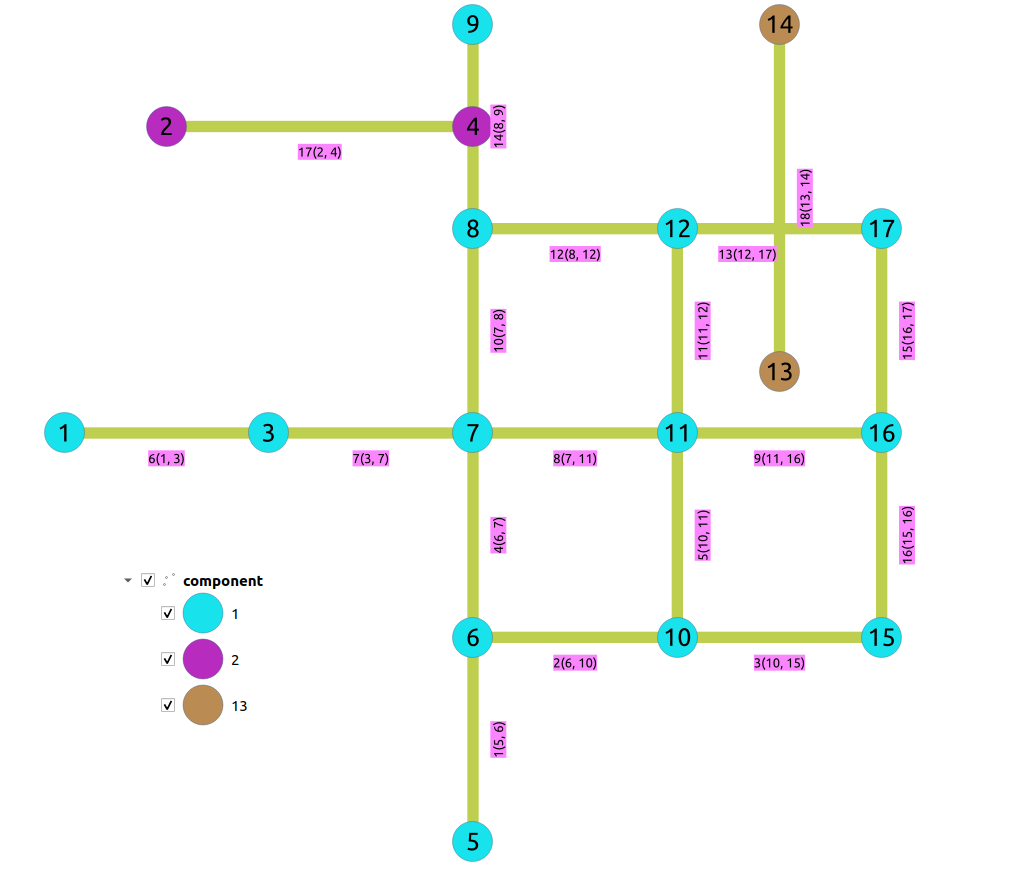pgr_connectedComponents - pgRouting Manual (3.8)
pgr_connectedComponents
pgr_connectedComponents
- Connected components of an undirected graph using
a DFS-based approach.
Availability
-
Version 3.0.0
-
Result columns change:
-
n_seqis removed -
seqchanged type toBIGINT
-
-
Function promoted to official.
-
-
Version 2.5.0
-
New experimental function.
-
Description
A connected component of an undirected graph is a set of vertices that are all reachable from each other.
The main characteristics are:
-
Works for undirected graphs.
-
Components are described by vertices
-
The returned values are ordered:
-
componentascending -
nodeascending
-
-
Running time: \(O(V + E)\)
Signatures
- Example :
-
The connected components of the graph
SELECT * FROM pgr_connectedComponents(
'SELECT id, source, target, cost, reverse_cost FROM edges'
);
seq component node
-----+-----------+------
1 1 1
2 1 3
3 1 5
4 1 6
5 1 7
6 1 8
7 1 9
8 1 10
9 1 11
10 1 12
11 1 15
12 1 16
13 1 17
14 2 2
15 2 4
16 13 13
17 13 14
(17 rows)

Parameters
|
Parameter |
Type |
Description |
|---|---|---|
|
|
Edges SQL as described below. |
Inner Queries
Edges SQL
|
Column |
Type |
Default |
Description |
|---|---|---|---|
|
|
ANY-INTEGER |
Identifier of the edge. |
|
|
|
ANY-INTEGER |
Identifier of the first end point vertex of the edge. |
|
|
|
ANY-INTEGER |
Identifier of the second end point vertex of the edge. |
|
|
|
ANY-NUMERICAL |
Weight of the edge (
|
|
|
|
ANY-NUMERICAL |
-1 |
Weight of the edge (
|
Where:
- ANY-INTEGER :
-
SMALLINT,INTEGER,BIGINT - ANY-NUMERICAL :
-
SMALLINT,INTEGER,BIGINT,REAL,FLOAT
Result columns
Returns set of
(seq,
component,
node)
|
Column |
Type |
Description |
|---|---|---|
|
|
|
Sequential value starting from 1 . |
|
|
|
Component identifier.
|
|
|
|
Identifier of the vertex that belongs to the
|
Additional Examples
Connecting disconnected components
To get the graph connectivity:
SELECT * FROM pgr_connectedComponents(
'SELECT id, source, target, cost, reverse_cost FROM edges'
);
seq component node
-----+-----------+------
1 1 1
2 1 3
3 1 5
4 1 6
5 1 7
6 1 8
7 1 9
8 1 10
9 1 11
10 1 12
11 1 15
12 1 16
13 1 17
14 2 2
15 2 4
16 13 13
17 13 14
(17 rows)
There are three basic ways to connect components:
-
From the vertex to the starting point of the edge
-
From the vertex to the ending point of the edge
-
From the vertex to the closest vertex on the edge
-
This solution requires the edge to be split.
-
In this example pgr_separateCrossing and pgr_separateTouching will be used.
Get the connectivity
SELECT * FROM pgr_connectedComponents(
'SELECT id, source, target, cost, reverse_cost FROM edges'
);
seq component node
-----+-----------+------
1 1 1
2 1 3
3 1 5
4 1 6
5 1 7
6 1 8
7 1 9
8 1 10
9 1 11
10 1 12
11 1 15
12 1 16
13 1 17
14 2 2
15 2 4
16 13 13
17 13 14
(17 rows)
Prepare tables
In this example: the edges table will need an additional column and the vertex table will be rebuilt completely.
ALTER TABLE edges ADD old_id BIGINT;
ALTER TABLE
DROP TABLE vertices;
DROP TABLE
Insert new edges
Using pgr_separateCrossing and pgr_separateTouching insert the results into the edges table.
INSERT INTO edges (old_id, geom)
SELECT id, geom FROM pgr_separateCrossing('SELECT * FROM edges')
UNION
SELECT id, geom FROM pgr_separateTouching('SELECT * FROM edges');
INSERT 0 6
Create the vertices table
Using pgr_extractVertices create the table.
CREATE TABLE vertices AS
SELECT * FROM pgr_extractVertices('SELECT id, geom FROM edges');
SELECT 18
Update the topology
/* -- set the source information */
UPDATE edges AS e
SET source = v.id, x1 = x, y1 = y
FROM vertices AS v
WHERE ST_StartPoint(e.geom) = v.geom;
UPDATE 24
/* -- set the target information */
UPDATE edges AS e
SET target = v.id, x2 = x, y2 = y
FROM vertices AS v
WHERE ST_EndPoint(e.geom) = v.geom;
UPDATE 24
Update other values
In this example only
cost
and
reverse_cost
are updated, where they are
based on the length of the geometry and the directionality is kept using the
sign
function.
UPDATE edges e
SET cost = ST_length(e.geom)*sign(e1.cost),
reverse_cost = ST_length(e.geom)*sign(e1.reverse_cost)
FROM edges e1
WHERE e.cost IS NULL AND e1.id = e.old_id;
UPDATE 6
SELECT * FROM pgr_connectedComponents(
'SELECT id, source, target, cost, reverse_cost FROM edges'
);
seq component node
-----+-----------+------
1 1 1
2 1 2
3 1 3
4 1 4
5 1 5
6 1 6
7 1 7
8 1 8
9 1 9
10 1 10
11 1 11
12 1 12
13 1 13
14 1 14
15 1 15
16 1 16
17 1 17
18 1 18
(18 rows)
See Also
-
wikipedia: Connected component
Indices and tables
